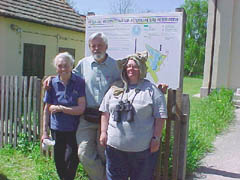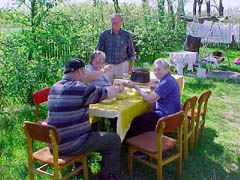|
Journal of a Sabbatical |
||||||||
|
April 29, 2001 |
|
|
endurance birding |
|||||
|
|
|
|
|
|||||
|
Today's bird
sightings: Today's Reading: Budapest 1900 by John Lukacs Plum Island Bird List |
|
|
Given my propensity to sleep through the major events of my life and miss planes trains and automobiles (actually that hasn't happened that often but it makes a good exaggeration) I was afraid that meeting Zsolt and his mother outside the Bug House (house of entomologists) at quarter to 6:00 in the morning might be more of a stretch than I could manage. However, I was washed, dressed, breakfasted, and on my way out the door when they arrived. What timing! The first order of business was to pick up Famous Hungarian Ornithologist (hereinafter referred to as FHO) and his Canadian Friend (hereinafter known as CF) at some metro station that Zsolt had never been to. We drove around and asked for directions about 15 times. The location of the station was not immediately obvious to the casual observer. We did find it however, which is good because it turns out that we were responsible for delivering FHO to Kiskunsag National Park where he was scheduled to lead a once a year bird walk. Birders were waiting for him at the gate when we arrived. I somehow knew they weren't there to welcome me. Oh, I'm glossing over the fact that this was like a two hour or so drive from the Metro station out onto the plain. Vastly different terrain from Budapest. Along the way, we stopped for coffee at a small roadside restaurant in the middle of nowhere. It was full. There was no place for us to sit. A bus full of tourists took over the whole place for an official tourist gulyas meal on the plain. We couldn't tell what country they were from by their language, but from close inspection of the bus license plate while we walked around drinking our coffee in the parking lot we discovered they were from Moldavia. The Moldavians were still eating their gulyas soup when we finished balancing our coffee cups on a rickety old horse cart that adorned the parking lot (read unpaved dirt area for parking lot). For all I know they were still eating their gulyas soup when we arrived at the bird refuge. At the refuge, FHO introduced us to the park warden who is apparently a friend of his. The warden was not feeling well, but since this is a once a year event he rallied to co-lead with FHO. We ended up waiting awhile at the head of the trail for some birders who had called on their cellphone to say that the bus had dropped them off some distance from the refuge and they were walking. While we waited for them, FHO tried to find a nightingale for me. We could all hear it singing but it was well hidden in the tree foliage. We also looked for some small green warbler that we didn't find either. European goldfinches were all over the place in plain sight. We could also hear orioles but didn't find them either. Finally the birders we awaited arrived and we started walking down the dirt road/trail that leads to the two lakes of Peteri Lake Bird Reserve. The place is alive with frogs, loud frogs, calling to each other ceaselessly, sometimes jumping into the water from the bank, sometimes jumping onto each other. I told Zsolt this is a frog paradise as well as a bird paradise. He wondered aloud what they say to each other. Do they tell long narratives? That's a nice romantic notion, but I told him what they are really saying is "f**** me or f**** off". Egrets are everywhere. In the trees. In the lake. On the wing. Purple herons too. And I spotted a squacco heron perched in a tree. It's a smallish heron with a light brown color on the back, very elegant looking yet compact. I had to look it up in the book because we'd gotten ahead of FHO, but he confirmed my description. And there were ducks, ducks, and more ducks. Common pochard, which look sort of like the canvasbacks we have at the cove at home, and shovelers, and stuff like that. Zsolt points out something he identifies as "big grub". Big grub? My brain processed slowly as I focused the binoculars on a great crested grebe. Big grub=big grebe! Eek. I'm learning Zsoltish! A family of greylag geese swam by, two adults and four goslings. I wrote them down in the notebook, then about 500 yards farther along I came upon a goose farm. Thousands and thousands of geese in a fenced in yard waiting to be made into foie gras. Maybe the goose family are escapees? But greylag goose does breed here so I guess I can count them. Zsolt's mother, who is 86, fell behind at the goose farm and decided it was too hot for her to keep going so she stayed there until we came back from the point where you can view both lakes - the end point of the bird walk. It was very hot and sunny. I quickly realized that a mere baseball cap was not going to do much for sun protection so I tied my outer shirt into a turban like thing to protect my head and neck. I looked ridiculous, but it really helped. It was a long walk to the two lake place and back to the warden's house and I was plenty tired when we got back. I doused my head with the garden hose before I even had a drink of water. Zsolt wanted to know if that was some New England custom. He claims he'd never seen anybody do that before. I sought out shade while we waited for the traditional spicy fish soup lunch to be ready.
After lunch it was off to search for Otis tarda, the great bustard. FHO had several spots in mind to check. Apparently the great bustard is hard to find despite its huge size. It's shy and reclusive, not to mention rare, so I kind of psyched myself into this "even if I don't see one at least I will have tried" mind set. So we wound our way through dusty side roads lined with thatch roofed houses, ancient csarda buildings, and dogs. I was already sunburned and exhausted after a full day of lakeside birding and now it was time to go out into the plain at dusk after a very brief stop for a cold drink at some restaurant or other that was open. This is a long holiday weekend because May Day falls on a Tuesday so everybody has Monday off too. Nothing is open to begin with on Sunday and even less on Sunday of a long holiday weekend. Just outside Szbadsalles we stopped at the first place on FHO's list of possible Otis tarda places and we hit the jackpot. We had only been there a few minutes scanning the plain with binocs when we saw one large neck with trailing white plumes sticking up above the tall grass on the edge of a ploughed field. All eyes and optics went right to it. Then to the right of it, three more obvious great bustards started walking across the field. We watched them walk very fast for awhile, then the male who was off by himself began to display. FHO trained the scope on him and we took turns watching the display. He extended his wings and tail feathers all puffed up two about two and a half times his normal size and walked back and forth - or should I say strutted - with a regal air. He turned around so we (well probably so any females nearby) could get a good view of his feathery butt. It reminded me of one of those native American dances they do at powwows where the dancer turns around and around in a slow stately manner. I couldn't get enough of watching it. I have to say that FHO gives good Otis tarda. It was a life bird for Zsolt's mother too (she's a birder) and she was as excited as I was. Zsolt had never seen one outside a zoo and was enthralled as well. It was spectacular. I regretted that it was too dark to attempt a picture with the Mavica through the scope, but I will always have the picture in my mind. The day was of course still not over though it was now dark. We had to find the correct train station at which to return the FHO and the CF, then we had to find the Kecskemet Arboretum where we were to stay the night. We succeeded with the train station, but we had to ask directions about 10 times to find the Arboretum and then the gate was closed when we got there. We were supposed to call a neighbor who has a key to let us in, but we were not carrying a cell phone (it's like China here, everyone assumes everyone else has a cellphone). Zsolt left us at the gate and went to knock on the neighbor's door. Fortunately, it was the right neighbor and we were expected. The guest rooms at the arboretum look very inviting. Very very inviting. Birding is definitely an endurance sport. |
|||||
|
|
|
Copyright © 2001, Janet I. Egan |
|||||
 Up
at the crack of dawn, actually before the crack of
dawn...
Up
at the crack of dawn, actually before the crack of
dawn... Fish
soup is kind of a misnomer because the main ingredients are
paprika, onions, and potato. The fish is secondary, and
practically unnecessary. In fact I gave my piece of fish to
Zsolt and just ate the soup with the added homemade noodles.
The feast was prepared by the park warden's wife and served
in a big metal cauldron. FHO and the park warden seem to be
old friends, but then again all Hungarians seem to be best
of friends on first meeting. I had not realized that Zsolt
had never met FHO until we picked him up at the metro
station this morning. He says it's the Hungarian
way.
Fish
soup is kind of a misnomer because the main ingredients are
paprika, onions, and potato. The fish is secondary, and
practically unnecessary. In fact I gave my piece of fish to
Zsolt and just ate the soup with the added homemade noodles.
The feast was prepared by the park warden's wife and served
in a big metal cauldron. FHO and the park warden seem to be
old friends, but then again all Hungarians seem to be best
of friends on first meeting. I had not realized that Zsolt
had never met FHO until we picked him up at the metro
station this morning. He says it's the Hungarian
way.